Too many asymmetrical poses can create sacroiliac joint issues
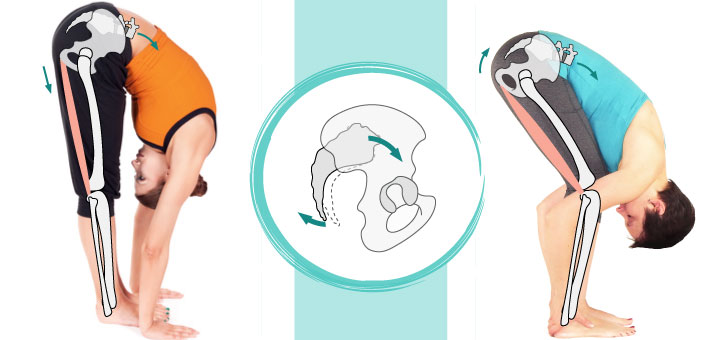
I must admit: before I started my viniyoga teacher training, I’d never heard of sacrum issues. Sure, I knew what sacrum was, but my first teacher training program never talked about it, my students never complained about it, and I haven’t had any trouble myself. I’ve moved through life blissfully unaware until I started my viniyoga teacher training. Then, all of a sudden, the sacrum became front and center. I would hear, “This pose can be problematic if you have sacrum issues,” “Do this to take care of your sacrum,” “Make sure you don’t feel any discomfort in your sacrum,” etc. You know how when you decide to buy a certain car you start seeing it everywhere? The same happened to me with the sacrum. All of a sudden, I’ve discovered that sacrum issues are everywhere, and certain yoga practices often create or contribute to the problem.
Well, to be more specific, it’s not really the sacrum that we have issues with, but the sacroiliac (SI) joints. Quick anatomy reminder: sacrum is located at the base of your spine and consists of 5 vertebrae that are fused together to form a bone about the size of your hand. It fits snuggly between the two sides of your pelvis and is connected to them via the sacroiliac joints. SI joints are weight-bearing because the sacrum bears the weight of the spine and transfers it through those joints to the pelvis and then down into the legs. Like any weight-bearing joint, it needs to be stable, so there are several ligaments that bind the sacrum to the pelvis to restrict its movement.
Now, some of us have more mobility in the sacrum than others, and that’s what can create potential problems. The sacrum has an ability to tip slightly forward in relation to pelvis (called nutation) or slightly back (counternutation). It can tip 5-10% at most, but even that can create a sense of instability in the pelvic area.
Who is at risk?
Anybody can suffer an SI injury but the following populations are at a much greater risk:
- Women of reproductive age. Theoretically, the movement of the sacrum is designed to accommodate the passing of the baby through the pelvis: first, a counternutation for the head to enter the pelvis and then nutation to get the tailbone out of the way. We all know that in pregnant women, the hormone relaxin is released, which makes the ligaments laxer for the same purpose of accommodating the birthing process. Whether or not your students are pregnant right now, if they are of reproductive age or have given birth before, they are more likely to have more mobility in their SI ligaments.
- Ligamentous folks. Some of us were born with looser ligaments, which enables us to do more advanced yoga poses, but also puts us at risk for SI issues because of extra sacrum mobility.
The problem
That young, uber-flexible girl in your class who is happily trying to stick her foot behind her head runs the risk of pulling or injuring her SI ligaments. Her sacrum is more likely to pop out of place, usually on one side, and once it’s out of place, it will pull on the ligaments that are supposed to keep it in place, causing sharp, obnoxious pain on one side of her lower spine. As we know, ligaments are highly avascular, which means that if there is a tear in a ligament, it will take a long time to heal because of poor circulation to the area. Unfortunately, once you injure the area, you are likely to reinjure it again, especially if you maintain an advanced yoga practice and ignore your body’s pain signals. We say that a student has a “hot sacrum” if her SI joints are sensitive and prone to injury. Folks like that will have to modify their yoga practice dramatically while in the healing stage; otherwise, they will keep reinjuring it and turn it into a chronic problem.
What can we, as teachers, do to minimize the risk of sacroiliac injury?
1. Approach advanced asymmetrical poses with great care, especially those where one hip is in a fixed position, and the spine is strongly pulled the other way. Look at Janu Sirsasana, which is not necessarily an advanced posture but typically aggravates “hot sacrums.”
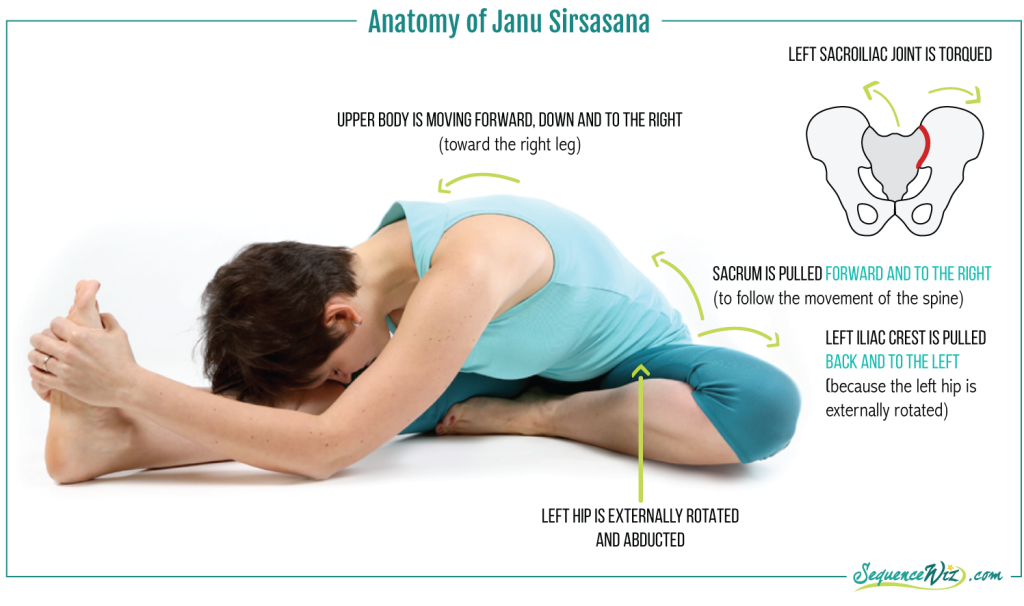
It is wise to take the following precautions for any advanced asymmetrical posture:
- Do not use arm leverage to pull yourself into the pose if you sense resistance in your SI joints.
- Make sure that the students’ bodies are adequately prepared before they attempt a posture (read more on how to prepare the body for a difficult posture)
- Please, please, please DO NOT demonstrate advanced poses if you are not warmed up appropriately yourself. This is a major source of injuries for yoga teachers.
- Remind your students (and yourself) to stop if it hurts.
2. Do not teach too many asymmetrical poses on one side, it can lead to cumulative stress on the SI joint. I was recently in a class where the teacher did the following poses:
This entire sequence was done on one side first, holding each pose for 4-6 breaths, without any cueing about changing the position of the feet or using abdominal contraction for support. Do you see a problem here? The position of your left leg is fixed, which means that the left side of the pelvis will be anchored in a mostly forward-facing position. Then, you move your spine through a side bend, forward bend, back bend, side bend, and then twist. Your sacrum follows the movement of your spine, tugging, twisting, and torquing your left SI joint. This reminds me of trying to pull off the top of a plastic bottle – to break the thin piece of plastic, you would bend it forward, bend it back, twist it one way, then the other, and hopefully, it will come loose after that. Why would you want to do that to your SI ligaments? They won’t break off, of course, but they will get destabilized and become more vulnerable and susceptible to injury.
Solution: Switch sides more often and alternate asymmetrical poses with symmetrical forward bends.
3. Do not insist on keeping the legs straight in forward bends; it creates shear stress on the sacrum.
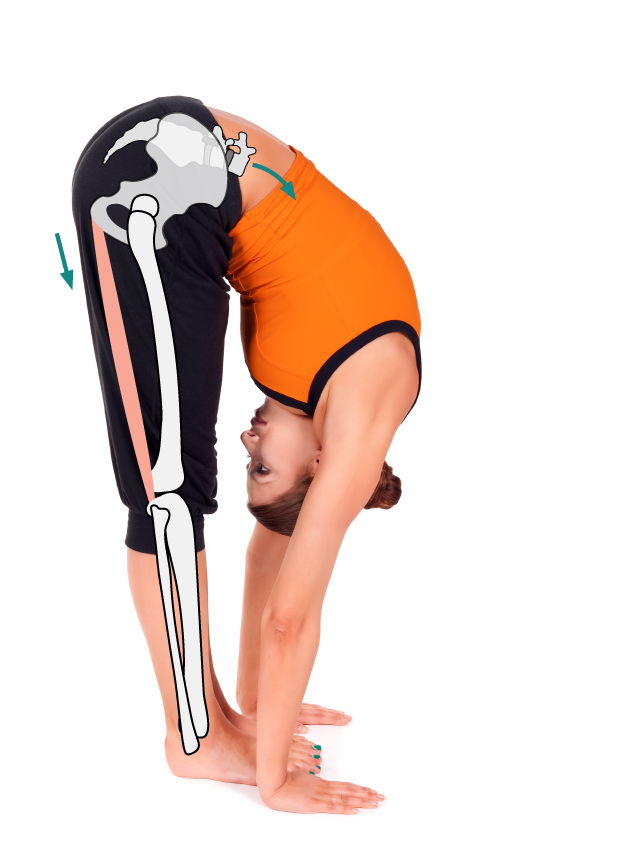
When you keep your legs straight
- The weight of the upper body is pulling the sacrum in the direction of the load (forward)
- Hamstrings act like tight ropes, pulling the pelvis backward
- The sacrum and pelvis are pulled in opposite directions with some force, which places both SI ligaments under shear stress
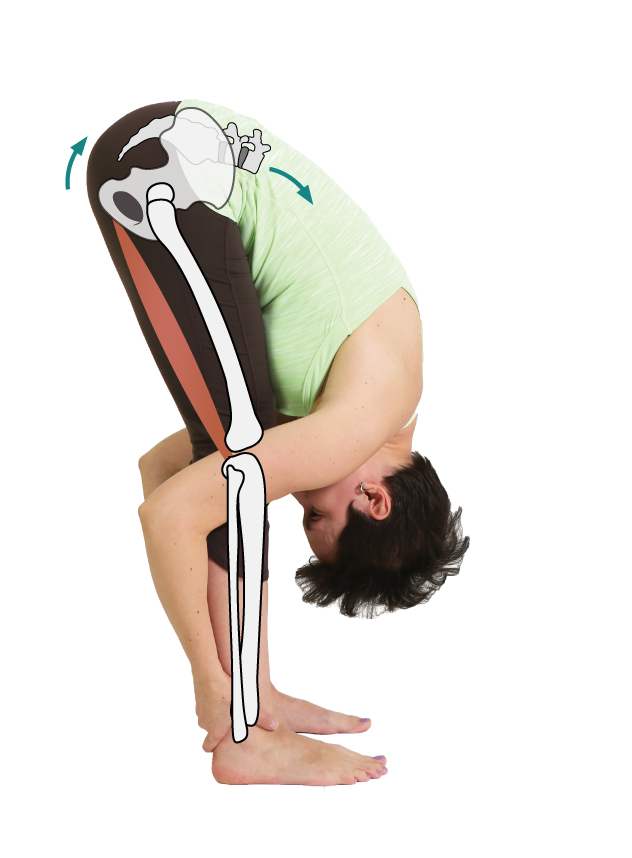
When you keep your knees slightly bent
- The weight of the upper body is pulling the sacrum in the direction of the load (forward)
- When knees are bent, hamstrings do not pull on the pelvis, and the pelvis is free to tip slightly forward to follow the movement of the sacrum
- Since sacrum and pelvis are free to move in the same direction, sacroiliac joints are not stressed
4. When you sequence your classes, be sure to include poses that stabilize the sacrum. In the traditional approach to sequencing summarized by Sri Krishnamacharya, prone backbends always follow the standing postures to make sure that whatever you have done to your lower back/sacrum area in standing could be neutralized via symmetrical prone poses.
Vimanasana is one of those “magic” yoga poses that does it really well. However, you need to make sure that
A. Your student’s back is strong enough to handle it
B. Your student keeps her pelvis grounded on both sides when she attempts it.
Why Vimanasana works so well
Outward movement of the legs encourages sacrum nutation (tipping forward in relation to the pelvis). When the legs move outward, the sit bones move out as well, and the two pelvic rims move toward each other.

Moving the legs toward the center encourages sacrum counternutation (tipping backward in relation to the pelvis). When the legs move toward each other, the sit bones move in as well, and the two pelvic rims move outward.

Lifting the upper body helps to keep the pelvis grounded. Moving the legs out and in encourages a slight tipping of the sacrum back and forth, which can help realign the relationship between the sacrum and the pelvis. This movement also strengthens the structures that support and protect the SI ligaments (lower back muscles, glutes, deep rotators, etc.).
These are some simple basic ideas that are not hard to implement, but they will help protect your students’ SI joints. If your student does get injured in the class or elsewhere, it is best to limit or eliminate the activities that irritate the area, including one’s yoga practice. Once the acute stage has passed, she can seek guidance from a physical therapist or a qualified yoga therapist on how to stabilize and strengthen the sacrum area before returning to a regular yoga practice.

Got a moody sacrum? Check out this short, targeted yoga practice that is likely to put your sacrum in a better mood.
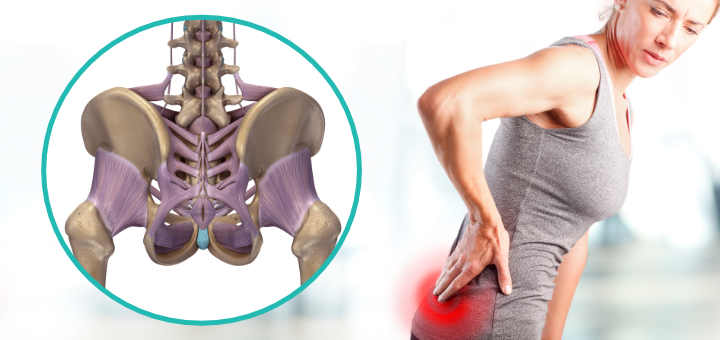
Lower back pain from sacroiliac issues is very common for women, but it is often misunderstood, misdiagnosed, and mistreated. Doctors often attribute this type of discomfort to a potential herniated disc, spinal stenosis, piriformis syndrome, sciatica, or some other issue. But in reality, it stems from sacroiliac joint dysfunction.
Additional resources on the subject:
Anatomy of Hatha Yoga: A manual for Students, Teachers and Practitioners by D. Coulter
The Female Pelvis Anatomy and Exercises by B. Calais-Germain
Protect the Sacroiliac Joints by R. Cole

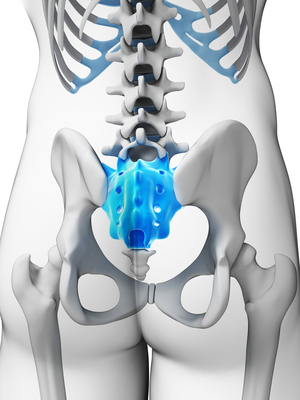
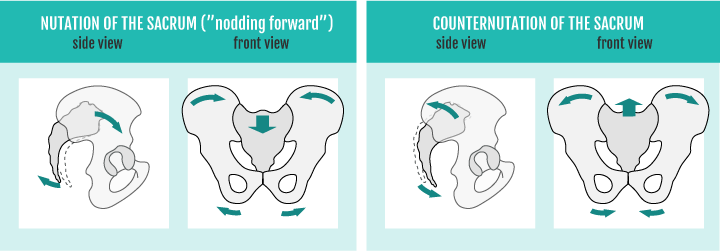


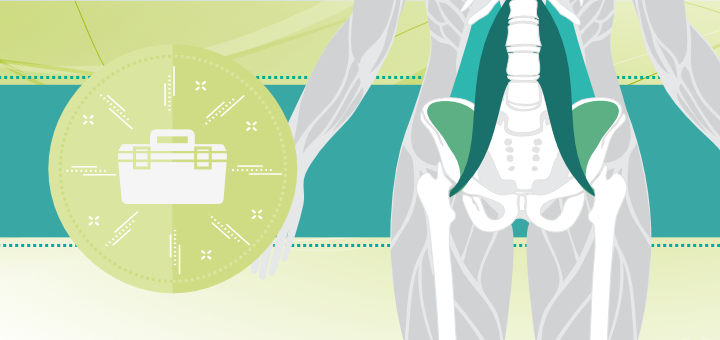
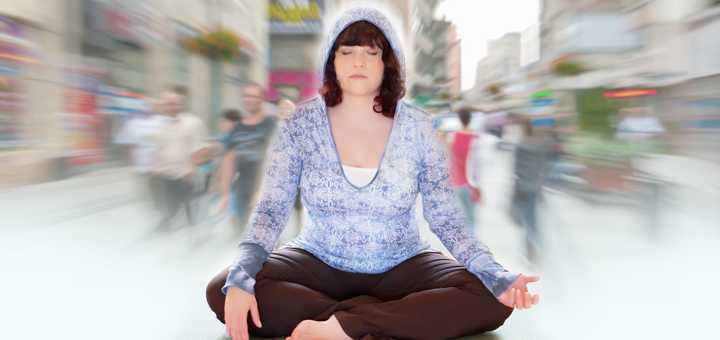







This is FANTASTIC. It addresses so many instruction issues with clear, understandable graphics for great sink-in-ability. From the power yoga contingent’s attachment to 6+ standing poses on one side to the case for knee-bending in uttanasana – I applaud this comprehensive analysis. Thank you! So glad to discover you. I’ll be sharing this (and surely many more of your posts) with the teachers at my studio, where I struggle to balance two often opposing things: offering diverse styles and ensuring responsible methods.
Thank you for your kind words Mary! I am happy to hear that you found it useful. I do not aspire to be a pioneer on any particular yoga subject, but rather to deliver what’s out there already in a manageable, visual way. I also checked out your blog http://www.realisthenewgood.com and I really appreciate your direct, to the point writing style and choice of topics. Edge-ucational? Brilliant!
Love the article, but men suffer from SI disfunction as well, and nowhere in the article was this addressed. Your piece was very informative, but it made it seem as though SI issues are only a problem for women. Speaking from personal experience and from 10 years of teaching, this is an issue for men as well as women especially due to the fact that men are much more likely to have overly tight hamstrings. Thank you for the article and for sharing your knowlege. Maybe a future update to include a few “him’s” and he’s” would be great…;)
Hi Joel! I completely agree – anybody can suffer an SI injury (I believe I said that in the article). And when I said “ligamentous folks”(anybody with looser ligaments) I meant men as well. It’s just more common for women, that’s why I used “her” throughout the post. 🙂
Oh no, the author didn’t use male defaultism, that means that men must have been left out COMPLETELY!
Wow. Just wow.
Unnecessary to bring up charges of sexism towards a fellow yogi in a great helpful site that is welcoming to all especially where they are unwarranted. Joel is correct that the article, while accurate and beneficial, by neglecting to address men and their common problems in the SI area, could cause a less experienced teacher to misunderstand a male students problems and potentially apply a one-size-fits all approach to a student with different anatomical and hormonal issues. After having injured my own SI joint twice in taking someone else’s class, I question whether a middle aged man with a minimally mobile SI joint should be encouraged to mobilize the joint at all, even if you call the mobilization “stabilization.”
Wow, Upsetting to be the same gender as mainsplainer Robert and poor Joel who can’t handle the use of she in a single article, while he has been used for centuries as the default.
Reblogged this on Yoga mit Andrea (YogaMand) and commented:
I.Love.Symmetry … you know that already. And here is the explanation because sometimes it’s nice and very helpful to hear (or read in this case) the same story in different words. Enjoy reading <3
Really interesting article; thank you!
I’m sure many teachers are familiar with students who really need to be bending their knees in forward folds, and see highly mobile students with straight legs and want to do the same. I love that now I have the anatomical rationale to back it up!
Thank you Kathryn! I was thinking the same thing – we need more a visual representation of what’s going on, that’s why I put it together. Glad you found it useful!
Great article! So, if one of the “dimples” on my lower back is lower than the other am I suffering from SI injury? I had a double hip replacement two years ago and have had lower back pain, stiffness and discomfort before AND after my surgeries. I was hoping the lower back pain would end after surgery… and SOME of it is gone; however, enough pain remains to make walking and standing for lengthy periods uncoformtable. Any advice?
Hi Billy! Sorry to hear about your back pain. Did you have your hips replaced at the same time or on 2 separate occasions? It is my understanding that with surgeries like that your doctor had to make sure that your pelvis is even after the procedure. If it doesn’t seem like that to you, may be the muscles on one side of your pelvis are tighter and pulling it up, which can in turn pull on the sacroiliac ligaments. Did your physical therapist have any insights? It’s super hard to tell what’s going on without in-depth exploration, since many different things are possible. Where do you live? If you are interested in giving yoga therapy a try you can find a qualified yoga therapist near you in this directory: http://www.viniyoga.com/learn-experience/viniyoga-teachers-and-yoga-therapists. He or she will do a thorough exploration of what’s going on and hopefully will have some suggestions on how to help you feel better!
Really well done. As a chiropractor, I can add: if the sacro-iliacs joints are not moving properly on one side do to previous injury (miroc or macro trauma) the other side will move to much to compensate ( hypermobility) and it will lead to pain. Your clients that suffer from this kind of problem should be evaluated by a chiropractor…
Excellent addition, thank you Anny!
You can also try an osteopathic doctor. A DO treated my SI joint with great success. I went to a chiropractor who tried to pop it back into place and I felt a lot worse for many years until I found the DO. He did more of a stretching-type technique that did not hurt. I messed it up again a few years ago when I slipped and fell on ice so I went back to the DO for another treatment. Complete relief both times.
completely agree on osteopathy!
I’ve been experimenting with deliberately controlling the SI Joint. The first step for me was learning to use the pelvic floor muscles to counter nutate the sacrum. The usual sequence that I use is to pull the tailbone towards the pubic bone. Then I pull the sitting bones inwards. The opposite action, I believe can be assisted by either the obturator internus and/or the iliacus. Generally to activate the obturator internus I focus on drawing the sitting bones outwards.
My own theory is that the pelvis, at extreme hip joint positions, is designed to change shape to possible give the thighs room to move relative to the pelvis, but also to allow for slight adjustments in tension of the hip joint so that the hip joint stays integrated. This could be like the shoulder blades moving relative to the ribcage so that the arm bones don’t impinge on the accromion process.
And so another possible solution for avoiding SI Joint pain is to learn to control the SI joint as well as feel it.
Hi Neil! I believe that we could all benefit from paying attention to our sacrums. Having said that, it probably requires some deep body awareness to tune in to such subtle movements and to manipulate them. Sounds like you know what you are doing – fantastic! For those who is not sure, I would recommend to start by paying close attention. Thank you for your comment!
This is great – so much info and so well written. I never really understood what the SI joint was til now – The illustrations are very helpful – and had no idea that tilt was affected by stabilizing exercises. So that’s why they feel so fantastic. Thanks!
Thank you Sharon, I am glad you found it useful! The illustrations were born out of my frustration with reading through anatomy texts with complex terms and poor images 🙂
Really good article, thank you very much for sharing! One thing that I also find useful, is to teach that the action of the buttocks in backbends and in poses like Vimanasana is: buttocks firm and “pointing”/lengthening towards the back of the knees (or heels), rather than buttocks firm and squeezing in towards the tailbone. This is a subtle difference, but even less experienced students usually get the idea, and it makes a huge difference for SI joint issues. You can practice this for eg. in an Ustrasana (camel) prep by putting your hands on your buttocks and guide the direction of the muscles down towards the floor as they engage.
Great Judit, thank you for sharing!
Thank you for the article! Very informative and love the diagrams.
I wondered what element lordosis plays in the health of the sacrum. I have an exaggerated lower back curve (I’m sure gymnastics and cheerleading are leading sources for that), and was curious as to what can be done to improve the overall state of my lower back. I have minor pain that ebbs and flows weekly. When I do a posture like two-knee twist or single-leg twist on the floor, my lower back ALWAYS pops deeply in both directions. It feels good, but makes me nervous! I am constantly aware of my posture and spinal positioning (curling tailbone under, etc.).
I’m sure all this is related to each other, just curious for input.
I have been practicing yoga for over 12 years, and have since focused more on traditional Hatha practice with a slow yin flow – avoiding the “push, push, push” you typically find in hot yoga. I’ve also adopted pilates/barre to help with strengthening my lower core muscles, thinking this will help compensate my lordosis and minimize chronic lower back pain. Luckily, I’ve not sustained any significant back injures…but as I age, I am starting to notice the subtle discomforts creeping into my backside!
Thanks for your feedback!
Hi Lana, thank you for your comment! For those of us who have lordosis, it is common to have loosy-goosy ligaments elsewhere, including SI ligaments. It sounds like you are on the right track – strengthening your core, avoiding overstretching and “push, push” mentality. I would be mindful about yin yoga as well – holding postures for long periods of time can destabilize the ligaments for those who already lack stability in that area. It might make sense to focus on strengthening, rather then stretching in your yoga practice, especially when it comes to the structures that support your lower back and sacrum – erectors, rotators, glutes, hip flexors, etc. I have couple of articles that might be useful to you, one about contracting muscles instead of stretching and one about abdominal support. As somebody who has loose ligaments, you are at a disadvantage – it’s harder to build stability in the body then it is to increase mobility. If you are interested, you can look up a viniyoga teacher in your area, we deal with similar issues quite a bit: http://www.viniyoga.com/learn-experience/viniyoga-teachers-and-yoga-therapists I hope that was useful!
VERY helpful indeed! Thank you so much for taking the time.
I look forward to using the resources you suggested. Thank you again so much for your insight!
I just discovered your site after a fellow yoga teacher posted this article on Facebook. I’d been in the process of drafting a blog post about my own experience with chronic pain in my SI joint due to a sports-related injury sustained 22 years ago (http://wp.me/p42ZHP-3L) and was thrilled to be able to include a link to your article.
Like Lana, I have lordosis and lots of flexibility. Only once among multiple stints in physical therapy have I been advised by a healthcare practitioner to stop doing yoga–without a reasonable or specific explanation that I can remember. As recently as last year, my PT offered no recommendations toward limiting or modifying my activities, which I found absurd because I know better and always advise my students to honor the changes in our aging or injured bodies.
I so appreciate the skill and insight with which you are offering this information and am sure I’ll be sharing your articles frequently!
Thank you Tara! Looking forward to reading your article!
Lana, all that has been said is very good info. As someone who also HAD lordosis and suffered many issues in the SI joint and impingement in nerves through the notch, I found that combining principles of Viniyoga (what the site writer studies) and Sadie Nardini’s take on moving the human body (hugely inspired by Kaminoff, whose main teacher was Desikichar – now you see the full circle here) saved my back big time, which fed into healing other parts of my body as well.
Thank you for this article,
This is the first time that I realize how lucky I migth have been. I have had a couple of particularly inspiring long term teachers but neither knew how to respond to this cracking in my lower back.. I would periodically have to pop myself back into place. I learnt later that this was in the sacroiliac. And I only now realize that goodness: I am pretty flexible and I am probably very lucky that my cracks and pops didn’t cause damage. It would be great to find a very knowledgeable teacher who could guide me through discomfort without me needing to pop the sacroiliac to realign it into comfort. Grateful that I got away with it, inspired to learn more. Thanks for the article. P.s. it would have been easier to look at the pictures if they contained a cross and a tick, indicating which picture is the better version. I understood it but I am thinking about casual readers who are not so involved with yoga but could misread something.
AHA! So every time I do a reclined twist and my lower back has deep ‘pops’ or when I lay down on a hard floor the tailbone resting at the base does a huge ‘pop’ shifting my lower vertebrates (and feels releasing in a good way) – is that “resetting” my sacram? Is that ok to do?
Twists are tricky – sometimes they can make SI problems worse and sometimes they can help you get things realigned. Fortunately (or unfortunately ?) SI joint reaction usually does not take long to manifest – minutes to hours. So if you feel good after your self-adjustments, then it is probably ok!
Hello,
I am always so happy to read articles that deal with proper posture and sequencing. My style of yoga, Kundalini, tends to focus on movement and breath versus alignment and perfect poses. I also work with pregnant women, whose joints are more labile. Your recommendation for the prone stabilization pose is not an option for pregnant women. I am curious to what you would suggest for this population and SI joint stabilization.
I thank you
Hi Ellyn! It’s a tough one. I don’t work with many pregnant women, but when I was pregnant myself I would do a modified Cobra with feet wide apart. I’d put a firm blanket under my pelvis right bellow the belly with feet on the floor and prop myself up on my forearms, so that the weight goes on the pelvis, not the stomach. I could even do a little in/out feet movement there. Doesn’t work for late stages though. So no, I don’t have an answer, since neither standing nor seated poses offer the same benefit. I would suggest you contact Clare Collins, if you feel like it, she is a fellow viniyogi who works extensively with pregnant women: info@yogaclarity.net Sorry I couldn’t be more help!
How does releasing the psoas affect the SI joints? Releasing my psoas through constructive rest pose, Feldenkrais, and trauma release exercises has completely eliminated my lower back pain.
Hi Meg – absolutely! Psoas is a major contributor to the asymmetries within the pelvic girdle, which in turn can pull SI joints out of alignment. I am happy to hear that you are pain free!
Thanks for this. I woke up just this morning wondering what I ever was going to do to help my SI instability/chrronic pain as I am a regular yoga practitioner and know that yoga both helps and further aggravates my SI and not sure what to do about it. Can’t stop doing yoga, so this info was really welcome and helpful.
I am so glad you found it useful, Paetra! Good luck with stabilizing your SI joint!
Loving all of your articles so much! As a yoga teacher who is just starting out, this website has taught me so much about the subtle aspects of the human body and the responsibilities an instructor has to protect it. I do have a question: When bending the knees in forward bends in order to protect the sacrum, it seems that one sacrifices the lengthening stretch in the hamstrings. Is this true, and if so, are there any safe ways to lengthen through the hamstrings without putting dangerous strain on the SI joints? Thanks again :]
Thank you for your kind words and what an excellent question! The safest stretch would be in a supine position (on the back) with one or both legs extended up. The student can just stretch up through the heels or use a strap or the hands if he can reach the feet. Another option would be to do a standing forward bend but with both hands on the wall or chair at about the height of the waist – that way you end up with more of a 90 degree angle between the thighs and the torso and the weight of the upper body is supported by something else. The student should try to keep the lumbar spine in a neutral position. Whatever you do, make sure to contract the hamies before you stretch them though!
This is a good article about the SIJ, which I have always considered the most important in our body. It is the keystone, and it is shaped as a key-stone. I am European and we have a lot of edifices built by Romans, over 2000 years back, and the parts that have the keystone are still standing.
BUT, it is too easy to ascribe SIJ problems to just asymmetrical postures. In the world of yoga, like in many others, we have dogmas: one of these is the deep breathing, loud breathing of Astanga-style (those guys must learn the Buteyko method). There are others, but the most detrimental to our topic here is the dogma which both schools share: Iyengar and Sivananda. This is the dogma:
In trikonasana and virabhadrasana II, the back hip (corresponding to the back leg) should be open. In another word, these two postures should be done like against a wall, with both hips stuck to the wall. I recall receiving terrifying adjustments in both schools: I was against the wall, in trikonasana, and another student was lying on her back in front of me. She then put one foot on my back hip, and PUSHED it to the wall. I felt terrible pain, and —this was years back, I would now refuse such a torture—I tried to bring my front hand down toward the floor.
I got out of this “adjustment” with a severe pain in my SIJ. Since this event, I am constantly dealing with a totally loose joint.
Until I saw another teacher, going from the standing position, legs apart, stretching forward, DELIBERATELY ALLOWING HER BACK HIP TO HAVE AN ANATOMICAL ROTATION, and she put her front hand next the the outside of her front foot. There she was in a perfect TRIKONASANA, and her SIJ’s ligaments were respected and not overstretched. I think I have a photo of one of my trikonasanas on my website or my FB, if you don’t understand. In trikonasana, my spine is—from coccyx to crowhead—parallel to the floor and not curved at the level of the hips.
This dogma is so strong, that even Bandhayoga and their beautiful computer-pictures show Iyengar-style trikonasana. Sorry, despite of the deep respect I have for the man (Iyengar) I absolutely oppose to the way his school imposes trikonasana, and by the same token virabhadrasana II.
Hi Dominique! Thank you for your comment. I happen to agree with your take on Trikonasana – I’ve explored it in depth in this post: http://sequencewiz.org/2013/08/29/there-is-no-such-thing-as-gold-standard-when-it-comes-to-alignment-in-yoga-poses/ I guess I could have mentioned it in this article, too, but I figured that it belongs in the first category of poses that I’ve described – advanced asymmetrical poses. But regardless, thank you for contributing and sharing your story!
These are all great tips. Perhaps if you would add above all to listen to your breath. The breath determines the bodies boundries: it opens and warms the area of work, your body then tells you if and when it is appropriate to move more deeply into the posture. Breathe into those edges, gently feeling for the consciousness waiting to be felt, heard and discovered -this can be far more interesting, challenging and beneficial than moving more fully into a posture – enjoy the journey not the destination!
Thank you Richard! I certainly agree – we are much less likely to hurt ourselves if we follow the lead of the breath rather then relying on the muscular force. That applies to any yoga practice.
I have just read your article on lessons-on-chronic-pain-and-postures. As I read and listened I noticed your intense focus on the physical, the structural and connective tissue. It occurred to me other than the mention of root – there was no mention of the energetic body, chakras or emotions! As a practitioner of healing for 27 years and teacher of Yoga for 18 years I attempt to look at the body as a barometer for what’s going on at all other levels! We are Energy before Matter. And something is mattering in your SI joint. Typically the second chakra but also your legs and first chakra (root) I find simple grounding exercises and meditations work wonders here. Perhaps a read of “Anatomy of the Spirit” will assist your awakening and processing of this challenge. As well Carolyn Myss’s Auido Series “Energy Anatomy” (not Advanced Energy Anatomy) would be highly beneficial (found at most public libraries). Anyway, ViniYoga is a beautiful tradition and I have seen a few VY teacher trainees with this same challenge. Hopefully you are just in process. Best to you
Hi Richard, thank you for your suggestions, even though they do sound a bit condescending. I am certainly aware of body’s subtle energies and the fact that they can have profound effect on our systems. However, I also believe that when somebody is experiencing a structural issue, one should approach it from the structural angle; when someone has a physiological issue, one should look at it from the energetic prospective and so forth. I disagree with your statement that “simple grounding exercises and meditations work wonders here”. I haven’t met a single student whose SI pain would be resolved by meditation alone. I tell my students sometimes that remedy should match the malady and I teach based on that principle. Sometimes evoking chakras is appropriate, at other time it isn’t. Best to you, as well.
Absolutely – the physical and structure is so important – it is our foundation and the form in which we express our Spirit. My apologies for intruding on your space.
No apologies necessary. Each one of us is a unique expression of the Spirit, as a result we approach our teaching in a unique personal way. That’s what makes yoga so multidimensional and insures that any student can find a teacher that resonates with him/her. Cheers!
Great content and I appreciate your common sense approach to anatomy and yoga and also your willingness to expose the blind spots that permeate the straight line approach to body mechanics in yoga. Flexibility is a huge liability and the emphasis on stretching rather than stabilizing is causing untold injuries in the long and short term of yoga practice. In the YogAlign method, which is a style I created to focus on good postural alignment rather than pose alignment, all practitioners bend the knees deeply in forward bending. Why? Because this activates the chain of extensors in the back body including the gluteals and simulates real life movement. The hamstrings are activated in an eccentric or lengthened contraction and the tension is taken off the sacral platform.
Chair sitting has weakened our backs and shortened our flexors. Why create the same anatomical dysfunction of a short front and strained back by doing straight knee forward bending?
Nobody walks without bending their knees so why are we trying to stretch forward in this fashion? When we do forward bends with the knees straight, the sacrum becomes the fulcrum for the tension created. It is like driving forward with the brakes on. Many female yoga practitioners have done so many forward bends that the sacral ligaments are so loose that the lumbar sacral curve is flattened. In other words, they loose their butt because the gluteals must be switched off to allow forward bending. The lumbar sacral curve is the most important shock absorbing force in the spine and the constant hip flexion that happens in way too many yoga poses is undermining the curve of the lower back. Even if one is very flexible and can basically hang from their joints, eventually they will suffer from instability in the knee and hip sacral joint as well as a lack of functional muscle tone needed for joint stabilization in everyday movement. The human body is a continuum and when yoga poses have a focus on stretching the ‘parts’ at the expense of the spine and SI joint, this is where injuries occur. Hamstrings and other muscles and fascial connections of the back body are for the most part strained and tense from the shortness of the flexor chains in the front body. Chair sitting has wired the flexors to be short and the hamstrings are in a state of tension because of it. But they do not need to be stretched, they need to be shortened and tightened to balance the shortness in the front body. If anyone has been injured, please take the survey at http://www.yogainjuries.com to help us all understand how and why these injuries are happening.
Fantastic article !!! Let’s hope all yoga teachers read and understand the dynamics of the sacrum & SI joints … I had a hip operation a few years ago and my hips pelvis and sacrum have been unstable since . I told my yoga instructor this … During downward dog he came up behind me and pressed down on my sacrum , as soon as he touched me I told him to stop but it was to late .. I’ve been in pain for the last 8 weeks because of this … So please all instructors out there please listen to what your students tell you !! I’ve been seeing a Chiro with no success … But will now switch to the osteopath …
Hi Ness, sorry to hear about your troubles. I would certainly echo your request for all yoga teachers to please, please listen to what the students are saying! And to be honest I am not a fan of hands-on adjustments in general, I think they do more harm then good. But this is a topic for another post. Good luck in your recovery process.
Thankyou. I have been trying to get this conventionally diagnosed for some time but can now just show the Dr this article.
I would also like to add that I am a man who does yoga. Not too fussed about the gender specifics, but a bit more generality may be appropriate!
Hi Chris, thank you for your comment. Of course, anybody can have sacrum issues, just a bit more common in women. Probably has something to do with those “pesky hormones” 🙂
Great article thanks.
In my own practice and my students with above average flexibility I have found that maintaining core strength is vital. I have and often suffer from SI pain. This flairs up when my core strength is not at it’s best and if I practice too many hip openers without the balance of core work.
I have also found that although back bends are great for stabilising the SI if I practice a deep back bend without properly engaging my core this can irritate my SI as the muscles in my lower back over tense and the squeeze on the area around my SI presses on the same over stressed nerves. So in all of this the core support is vital if I want to stretch. Once again it comes back to balance! Thanks again. Jess
Thank you for your comment Jessica; I couldn’t agree more. Core stability is certainly front and center in everything we do if we want to minimize the potential for injury. I talked about it here: http://sequencewiz.org/2013/06/21/how-to-protect-your-lower-back-and-increase-stability-in-any-yoga-pose/ I would also add that it is best to combine hip openers with hip strengthening and may be avoid deep back bends all together when the sacrum is inflamed.
I always have a therapeutic modification of supta padangustasana at the end of my cool down to reset the SI issues. A strong push of the femur into the back plane of the body by using hands for resistance while keeping the bottom femur on the floor well aligned and grounding down.
Thank you Leanne! I am glad to hear that it works for you. I probably wouldn’t expect everybody with sacrum issues to have a similar response. I am generally cautious of any moves that require a “strong push” one way or the other. If you can identify something that works for you every time, that’s great, but please be cautious in applying it to your students, since they might have a very different reaction. Thank you for contributing!
Oh Leanne… Please please DON’T do that …I had an instructor do that and im in so much pain .. And having treatment to correct the injury he caused … Youre probably a fantastic teacher but your NOT a osteopath , orthopedic surgeon or chiropractor and youre leaving yourself open all types of legal issues as what your doing is an “adjustment” and your not qualified to do this .Please don’t think I’m having a go I’m just gently pointing out the ramifications for the student( potential injury) and instructor ( potential legal action) T
As a hypermobile person, I flew into yoga and quickly felt I could do many poses which seemed difficult with relative ease. However, this was not really yoga; not a way to shift out of the habitual and into a more balanced, stable way of being. It was not until I found my teacher about ten years ago, Kim Schwartz, who has a strong Iyengar influence, that I had to restart from scratch and begin to look at every pose, and every action in every pose, as way to build stability. I disagree ASYMMETRY in asana alone causes SI joint pain/ instability; rather, it is key to understanding the anterior tilt/ untuck of the pelvis, the angle of the sacrum, and both the release and tone of the pelvic floor, and the how the weight is distributed/ the relationship through the joints of the legs. For instance, janu sirsasana can be quite therapeutic for an unstable SI if the correct action is applied to draw the sacrum forward with the pelvis. Standing poses with external rotation cannot safely be practiced with the pelvis “squared” to the long side of the mat, or else SI joints (and knees!) will be compromised, yet that is a common instruction in some circles. It is the way people are working, not the pose itself creating harm. I have found the muscular action of external rotation (as in viribhadrasana 2) combined with the anterior tilt of the pelvis has been hugely beneficial for healing sciatica. I am glad this topic has generated so much conversation, and that there is widespread interest in understanding. Thanks for writing the wonderful post!
Hi Avery; I couldn’t agree more. Poses themselves are neither good nor evil; it’s all about how we practice them and how we structure the practice to maximize the effect and minimize the stress on the body. And, of course, what works for one practitioner will not necessarily benefit the other, so individualized approach is always the best. I am happy to hear that you found a teacher that helped you rediscover yoga. Thank you for contributing to the discussion!
Great article. The one part I don’t quite follow is number 2, about switching sides more often. Typically in my Vinyasa classes, my teachers call out variations similar to what you described. Working one side of warrior 2 variations, vinyasa and then the other side.
My question is, why exactly is this bad? You are still getting symmetry since you are doing all the opposite poses on the other side as well. I find this style to be more interesting and keeps me more engaged then the back and forth of a single pose between switches side to side. Please elaborate on this.
Hi Brian! Thank you for your comment. The main reason it is not advisable to do too many poses on the same side at one time is that it puts repetitive stress on the joints and ligaments. It’s not so much about whether or not you are getting symmetry by doing the opposite side, it’s about stressing the ligaments on one side for too long. Basically, it’s destabilizing for them. I talked quite a bit about repetitive stress in this article, may be it will help you understand it better: http://sequencewiz.org/2014/04/09/shoulder-problems-yoga/
This article shed light on my now chronic SI issues. If I knew about the risks beforehand, I wouldn’t be suffering so much as I am now to try and counteract all the years of malpractice.
I was that very flexible girl in the class… My problems started right after giving birth to my daughter, now 10, and persist to this day. It was only after having had a resonance arthography that the problem started to become more clear, but still, what to do?
I’m in a process of “posture reeducation” in movement, expensive and also takes time and patience.
I’m still amazed about how difficult it is for me to be “gentle” with my body – as this type of postural training is very subtle and mellow. Maybe this is the most difficult pose of my life.
Hi Carla! Thank you for sharing your story. Indeed, learning to be gentle with ourselves is often the hardest lesson to learn…
Great advice – I wish I’d read this years ago!
I’ve just recovered from nagging SI issues. With hindsight, it’d been coming on for years. Bendy person, pushing in all the wrong ways into forward postures, collapsing into my lower back in backbends. In January it reached a point where I had to stop my two favorite things, running and yoga altogether for a few months.
Finally I had the sense to visit a chiropractor. It’s taken about 5 months, and now things are feeling back to normal. I was able to complete a full marathon a few weeks ago without any thigh pain (interestingly, SI problems manifest in runners as a constricted band in the back of your leg just above the knee). I haven’t had to ice in weeks, and this week I was able to (carefully) complete my yoga practice without pain. Yay!
I am so very mindful now of how I position my pelvis going into an asymmetric pose. My practice is still tentative, I know I could quite easily injure myself again.
Hi Megan; thank you for sharing your story! Congrats on getting out of the vicious cycle and good luck with your continuous recovery. Sounds like you are doing really well! I hope Vimanasana is part of your yoga routine – it makes a huge difference.
Thanks for saving us from sacroiliac joint issues, I was not aware of such things as well. However, I’m reading Pilates eBook from last 2 days and I am thinking of performing the exercises mentioned in the eBook, but I will like to know some of you also have followed this eBook and you got positive result or not.
Great article, thank you. I am studying for my Pilates Teacher Exam and your article was very helpful. Good teaching tips, not only for yoga teachers.
Thank you Silvia! I am happy to hear that other practitioners can use those tips as well. Good luck on your exam!
im starting a yoga class and found this information extremely helpful
Bless you! Please keep me updated.
This was an interesting article. However, I thought that I might take a moment to highlight some of the language used. You talk about students that have and “advanced yoga practice and ignore your (their) body’s pain signals”. It might be useful to consider that performing a complicated asana in such a way that you disconnect from your inner self might be reflective of an beginner or perhaps immature practice.
Thank you for your comment Mary! By “advanced” I meant “physically challenging”, which is how it is commonly used in the yoga world. Now, you and I know that the advancement in yoga is not measured by how challenging the pose is, but unfortunately we often see even experienced practitioners pushing through the pain and ignoring their body signals. I hope that this will change some day.
As a chronic SI joint sufferer for the past 8 years as a professional dancer, I have to speak up as a yoga teacher, and that one size does not fit all for SI joint issues. this article primarily speaks to the less mobile of SI joint sufferers, saying that it comes for the bones being forced into positions that torque on the pelvis. This is not true for all. Many people have overdeveloped muscle groups attaching to the hips that are twisting the pelvis out of alignment. For me personally, I have no problem with asymmetrical poses. Poses like restorative bridge pose cause me the most SI pain. Consider the exercise. With the upper body off the floor we are dealing with the erector spinae and quadratus lumborum firing, both strong muscles that can tug on the sacrum and back of the pelvic bowl, which can cause further SI instability. Again, this may be the answer for some, but not for all.
Great article! Hyper mobility of the ligaments/ soft tissue is a major concern for many people. As an Active Isolated Stretching and Strengthening Practitioner, the Aaron Mattes Method and STOTT PILATES Mat and Reformer Instructor with 25 years of working with bodies, I have found a way to help those with Hyper mobility learn to stabilize in order to mobilize safely. Our clients at Extreme Core Pilates are making tremendous progress with the Kathy Clark Method. Many of my clients have gone from being in major back pain, limiting there ability to be functional to running, surfing, outdoor cycling, or anything they want to do physically without fear of back issues. Our collegiate athletes have improve their athletic performance, but most importantly without injury. As we use a hydrating fascia prevention technique of stretching and strengthening all muscles in your body while learning to stabilize from deep core muscles.
thank you for this article. it is and was exactly my problem as a yoga teacher. i also learned to bend legs and that pose you mention -in a less clear manner- was explained to me by an osteopath. Anyway, it is a wonderful articulated article and I really appreciate it. I know how much pain is this pain, so I strongly recommend people follow your advice.
M y fave yoga teacher Fiona Ashdown (Classical yoga in the style of Deskikachar teaching in Southampton) tells me that yoga poses were designed for men and they usually have stiff hips cos they don’t have children. Watch out for all asymetrics. There are plenty of other things to do – so why risk your students – or yourself? How many Iyengar and Astanga students do you meet who have injuries? In my experience – quite a lot compared to more gentle, feminine forms of yoga.
Muchas gracias. Este articulo es de gran ayuda pues hace observaciones detalladas de lo que sucede anatomicamente cuando realizamos posturas comunes de yoga, Nos informa e invita a tomar medidas correctivas y de precaución. Importantes recomendaciones para prevenir que l@s alumn@s se lastimen,
I’m so grateful for this! I suffer from SI dysfunction and I wasn’t quite sure what I was doing wrong…specially doing yoga at home. This is very informative and I will keep in mind during my practice.
You are so welcome Diana! Hopefully those small changes will help!
Great article! For additional muscles strength, your patients should receive chiropractic care by adjusting their posture. It may help them with the advanced general yoga poses and advanced assymetrical poses.
I cannot thank you enough for this article! I’ve started having intense SI joint pain last year as I do sit almost all day even with regular yoga practice. I have good posture but I am a bit too flexible for my at home practice and although I was always careful not to overdo it, I guess I’ve underestimated the effect of my forward folds (and mostly one leg folds…). I am much more careful now and adapt my entire practice because I can get inflammed SI joint very easily, which is very uncomfortable!
Some truly excellent info, Glad I noticed this.
Great read!
Hallo,
Good morning,
6 months ago my pelvis was dislocated by an inexperienced ‘yoga teacher’ who did a short, hard push on my pelvis/sacrum, whilst I was in arms forward child pose. It was totally agony and couldn’t walk for months. I had my own unique daily practise, honed after many years, to alleviate suffering from disc problem in neck. I can not longer do this. I found your sequence, what poses should I leave out? And do you have anymore advice to help my recovery?
Thank you for your attention,
Jema